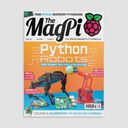rp2040
-
 07 Jun 2025 » Preparing for the coder dojoLast night, I got some preparation for today’s Coder Dojo KU Python Robotics activity. These are MicroPython robots based on an RP2040 (the Raspberry Pi Pico chip). The activity is aimed at kids learning to code. I have a fleet of 10 robots, plus 1 more as a demo/test model. It uses some of the principles from my books. These autonomous car type robots are built around the Cytron MakerPi RP2040 control board, with a dual RCWL-1601 sensor for obstacle avoidance, a Maker Line 5-sensor array, and a mini-3 round chassis. The code is written in MicroPython, and the kids write their own code to control them, with us providing activity sheets, reference cards, and helping out if they run into problems.more...
07 Jun 2025 » Preparing for the coder dojoLast night, I got some preparation for today’s Coder Dojo KU Python Robotics activity. These are MicroPython robots based on an RP2040 (the Raspberry Pi Pico chip). The activity is aimed at kids learning to code. I have a fleet of 10 robots, plus 1 more as a demo/test model. It uses some of the principles from my books. These autonomous car type robots are built around the Cytron MakerPi RP2040 control board, with a dual RCWL-1601 sensor for obstacle avoidance, a Maker Line 5-sensor array, and a mini-3 round chassis. The code is written in MicroPython, and the kids write their own code to control them, with us providing activity sheets, reference cards, and helping out if they run into problems.more... -
 Line following robots are a great example of autonomous robot behaviour. In this article, I will show you step-by-step how to add a line sensor to a Raspberry Pi Pico robot, how to wire it in, and then how to write Python code for responsive line following on the robot. I include CircuitPython and MicroPython examples.more...
Line following robots are a great example of autonomous robot behaviour. In this article, I will show you step-by-step how to add a line sensor to a Raspberry Pi Pico robot, how to wire it in, and then how to write Python code for responsive line following on the robot. I include CircuitPython and MicroPython examples.more... -
 01 Aug 2023 » Making a robotic foam dart turret with sound effectsToday I took the Foam Dart turret I made for my 2020 Piwars robot “Bangers and Bash”, which had some problems around power handling, and having attached it to a Pimoroni Yukon, got it to make sound effects before firing a spread of 5 foam darts. Not sure it is perfect for mowing down Piwars targets in a challenge as the spread is not so much aimed but uniform.more...
01 Aug 2023 » Making a robotic foam dart turret with sound effectsToday I took the Foam Dart turret I made for my 2020 Piwars robot “Bangers and Bash”, which had some problems around power handling, and having attached it to a Pimoroni Yukon, got it to make sound effects before firing a spread of 5 foam darts. Not sure it is perfect for mowing down Piwars targets in a challenge as the spread is not so much aimed but uniform.more... -
 04 Jul 2023 » Me and MeArm in The MagPiI have contributed to a feature published this month in The Magpi - the Raspberry Pi Magazine. In it I show how to use a Raspberry Pi Pico with a MeArm robot arm, and use Micropython to program a web controlled robot with step record and playback capabilitiesmore...
04 Jul 2023 » Me and MeArm in The MagPiI have contributed to a feature published this month in The Magpi - the Raspberry Pi Magazine. In it I show how to use a Raspberry Pi Pico with a MeArm robot arm, and use Micropython to program a web controlled robot with step record and playback capabilitiesmore... -
08 Apr 2022 » Raspberry Pi Pico Wifi and Wireless
-
08 Feb 2022 » Raspberry Pi Pico USB tip